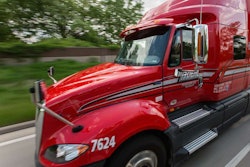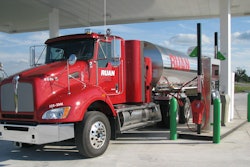 A CIO panel discussion at the ALK Transportation Technology Summit centered on mobile apps. Left to Right: Bill Cassidy (moderator), Tom Benusa, John Paape, John Reed
A CIO panel discussion at the ALK Transportation Technology Summit centered on mobile apps. Left to Right: Bill Cassidy (moderator), Tom Benusa, John Paape, John ReedFleet owners and executives expect a lot from their information systems and the people responsible for keeping them up to date.
On May 6, a panel of IT leaders said they have been given a directive to attract, recruit and retain drivers with technology.
“This is the year of the driver,” said panelist Tom Benusa, chief information officer of Transport America, a truckload carrier with 1,450 trucks based in Eagan, Minn.
Benusa joined two other IT executives on stage at the ALK Transportation Technology Summit in Princeton, N.J.
John Reed, chief information officer of AIM NationaLease, is following the same marching order: “Our executives are looking for efficiencies and to keep drivers pleased and how we can retain them long term,” he said. “Recruiting and retention are huge.”
The panel agreed that mobile applications are the best way to accomplish this feat.
John Paape, vice president of technology for Roehl Transport, said drivers between the age of 24 and 29 are a very important demographic to recruit and retain.
“They have grown up with a screen in their hands,” he said. “A lot of younger employees are coming in wanting to do work on their phone.”
Roehl provides dry van, refrigerated, flatbed and dedicated services, but Paape described the company in different terms: “We are a technology company that does transportation.”
Last month, Google announced it was changing its algorithm for mobile searches. Websites designed to be mobile friendly will be better positioned in search results. To align with this change, Roehl has a “mobile first” strategy, he said. All of its websites and applications are developed to be mobile friendly, especially those that drivers interact with.
A mobile app, released 18 months ago, keeps drivers connected with company information, inside and outside of trucks. Today more than 80 percent of drivers for the Marshfield, Wis.-based carrier actively use the MyRoehl app.
“From a driver perspective, it is a great mobile platform. We are replicating everything we do on our in-cab units,” he said. Drivers can submit paperwork, access pay information, and monitor performance metrics that are used to determine future pay increases.
Drivers can also submit feedback for the app for Roehl to incorporate into future releases, and use a “quick call” feature to contact their fleet manager and anyone else in the chain of leadership.
“If drivers need something, or they are not happy, they have a way to reach out,” he said.
Roehl continues to pursue new gamification features to enable drivers to compare their performance metrics against company goals and the rest of the fleet in a real-time format, similar to a Fantasy Football approach.
Transport America will soon be launching a mobile app to extend some features of its in-cab computing platform to drivers’ personal devices, Benusa said.
“Drivers are used to having devices all the time. They expect to press ‘Go’ and be told where to fuel and where to take a break,” he said. “We see technology as being one of the solutions to the driver shortage by keeping them connected to their pay, to their lifestyle, and to their homes.”
AIM NationaLease is planning to do “a lot more” with mobile, said Reed. Drivers and lease customers can now use a mobile application to submit electronic inspection forms. The company’s lease business has 5,000 tractors and 4,000 trailers. Its AIM Integrated Logistics division operates dedicated fleets for various customers.
Besides launching a mobile app, providing a mobility infrastructure to drivers is a priority, Benusa said. Transport America has basic Wi-Fi services at all company terminals, but the challenge is to “keep it beefy enough to keep drivers satisfied.”
Perhaps the biggest challenge of mobility with drivers, the panel agreed, is protecting the off-duty time of drivers. Mobile apps enable drivers to work whenever and wherever they want. Like any other type of professional, drivers will be tempted to work after hours like sending a message to a fleet manager while in the sleeper berth.
“How do you protect that true rest break period?” Paape asked. “As you go mobile, how do you protect yourself legally?”
The ALK Transportation Technology Summit was held May 4-6 at the Hyatt Regency in Princeton, N.J.












